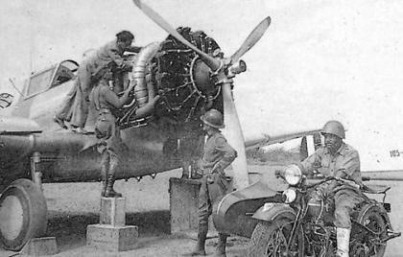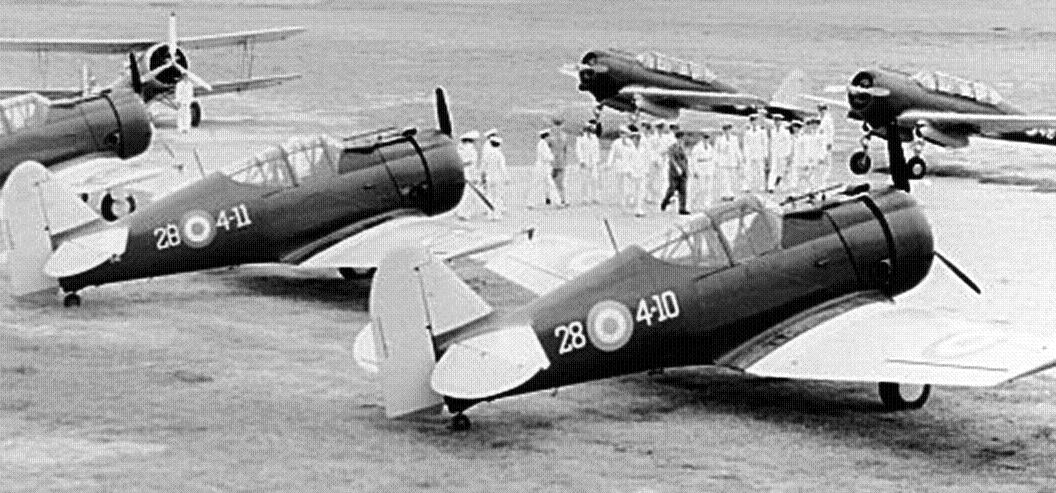A ceasefire agreement between the two countries came into effect on 31 July 1941. Both countries signed the Rio Protocol on 29 January 1942, and Peruvian forces subsequently withdrew. The enmity over the territorial dispute continued after 1942 and concluded following the Cenepa War of 1995 and the signing of the Brasilia Presidential Act agreement in October 1998.
Preparing for war
An agreement was signed in 1936 which recognized territories in de facto possession by each country. The resulting border is known as the 1936 status quo border line.
However, by 1938 both nations were once again holding minor border skirmishes. That same year, the entire Ecuadorian Cabinet, which was composed of high-ranking army officers who served as advisors for General Alberto Enríquez Gallo (who had taken charge of government after a military coup d'état), resigned from government in order to take command of the Ecuadorian Army.
Meanwhile, in Quito, there were public demonstrations of people chanting "Down With Peru! Long Live Ecuador!."
Peru's response to the events taking place in Ecuador was provided by foreign minister Carlos Concha, who stated, "In Peru we have not yet lost our heads. Our country is in a process of prosperous development and the Government heads would have to be completely mad to think of war." The social situation of Peru at that time was undergoing major changes, with the social reforms begun by president Augusto B. Leguia (which were aimed at improving roads, sanitation, industrial development, and promoting the general welfare of Peru's Native American population) being continued by president General Oscar Benavides.
On 11 January 1941, alleging that the Ecuadorians had been staging incursions and even occupations of the Peruvian territory of Zarumilla, the President of Peru, Manuel Prado, ordered the formation of the North Grouping, a military unit in charge of the Northern Operational Theater.
----------------------------
Ecuador


(All pictures are pinteres site)
According to the testimony of Col. Luis Rodríguez, the Ecuadorian forces at the disposal of the Army Border Command in El Oro (Lieutenant Colonel Octavio A. Ochoa) after the incidents of 5 and 6 July were as follows:
Forces deployed along the Zarumilla river: 3 superior officers, 33 officers, and 743 men, organized as follows:
"Cayambe" Battalion: 2 superior officers, 22 Officers, 490 soldiers.
"Montecristi" Battalion: 1 superior officer, 11 Officers, 253 soldiers.
Forces deployed in the immediate rear: 4 superior officers, 40 officers, 28 soldiers, 93 volunteers, 500 carabineros (a paramilitary Government force), organized as follows:
At Arenillas: 2 superior officers, 3 Officers, 14 soldiers.
At Santa Rosa: 2 superior officers, 1 Officer, 18 soldiers, plus the 93 volunteers, and the 500 carabineros.
----
Peru

Peru army: Soldiers in French uniforms, supported by Czech tanks, Italian artillery and American fighter planes doing battle against an enemy armed with German rifles and 19th Century European field guns.
------
As a result of the rising tensions on the border during 1939 and 1940, the Peruvian President Manuel Prado authorized in December 1940 the creation of the Agrupamiento del Norte (Northern Army Detachment). By July 1941, this unit was ready to begin active military operations.







(All these pictures are pinteres site)
Peruvian order of battle
Order of Battle, Agrupamiento del Norte, July 1941
Group Headquarters (Commander in Chief: Gen. Eloy G. Ureta; Chief of Staff: Lieut. Col. Miguel Monteza)
5th and 7th Cavalry Regiments
6th Artillery Group (8 x 105 mm guns)
Army Tank Detachment (12 x Czech tanks LTP)
1st Light Infantry Division (Col. Luis Vinatea)
1st, 5th, 19th Infantry Battalions
1st Artillery Group (8 guns)
1st Engineer Company
1st Antiaircraft Section
8th Light infantry Division (Col. César Salazar)
20th Infantry Battalion
8th Artillery Group (8 guns)
8th Engineer Company
Army Detachment "Chinchipe" (Lieut. Col. Victor Rodríguez)
33rd Infantry Battalion (2 Light Infantry companies)
Army Jungle Division (Northeast) (Gen. Antonio Silva)
Figures for total strength of the Agrupamiento del Norte at the beginning of offensive operations have been put at 11,500 to 13,000 men.
----------------------------------
Lieutenant José A. Quiñones was a Peruvian pilot during the war.
Ecuadorian wartime records of the downing differ greatly from Peruvian ones as Ecuador did not have any anti-aircraft guns located in the area, and the limited artillery located at the Machala was, due to a mistake by the minister of defence, useless as he ordered the wrong calibre of ammunition to be delivered to the units.
---------------------------------
The accounts as to which side fired the first shot vary considerably to this day. According to Peru's version Ecuadorian troops invaded Peruvian territory in the Zarumilla province, which started a battle that spread to a zone known as Quebrada Seca (dry creek). But Ecuador's version is that Peru took a series of incidents between border patrols as a pretext to invade Ecuador, with the intention of forcing it to sign a clear border agreement. They argue that the clear disparity of military presence in the region between the two countries supports this version.
The first clashes occurred on Saturday, 5 July 1941.
According to Peruvian accounts, some Ecuadorian troops from the garrison of Huaquillas, a town on the bank of the Zarumilla river, which then served as the status quo line in the extreme left of the Ecuadorian-Peruvian border, crossed into the Peruvian border post at Aguas Verdes, a town directly in front of Huaquillas, and opened fire on a Peruvian patrol. These troops were then followed by some 200 Ecuadorian armed men, which attacked the Police station at Aguas Verdes, to which the Peruvians reacted by sending an infantry company to Aguas Verdes and repulsing the Ecuadorians back across the Zarumilla. The fighting then spread to the entire border area along the Zarumilla river. By 6 July, the Peruvian aviation was conducting air-strikes against the Ecuadorian border posts along the river.
According to Ecuadorian Col. Luis A. Rodríguez, commander of the Ecuadorian forces defending the province of El Oro during the war, the incidents of 5 July started when an Ecuadorian border patrol found some Peruvian civilians, protected by policemen, clearing a patch of land on the Ecuadorian side of the river. Upon seeing the patrol, the Peruvian policemen opened fire, killing one soldier. This was followed by the widespread exchange of fire between troops on the opposing banks of the Zarumilla, while two Ecuadorian officers sent to Aguas Verdes to speak with the Peruvian local commanding officer were told by Peruvian authorities to go back to their lines.
Regardless, the much larger and better equipped Peruvian force of 13,000 men quickly overwhelmed the approximately 1,800 Ecuadorian covering forces, driving them back from the Zarumilla and invading the Ecuadorian province of El Oro. Peru also carried out limited aerial bombing of the Ecuadorian towns of Huaquillas, Arenillas, Santa Rosa, and Machala.
The Peruvian army had at its disposal a battalion of armor made up of Czech tanks, with artillery and air support. They had also established a paratroop unit in the region and used it to great effect by seizing the Ecuadorian port city of Puerto Bolívar, on 27 July 1941, marking the first time in the Americas that airborne troops were use in combat.
Faced with a delicate political situation that even prompted Ecuadorian President Carlos Alberto Arroyo del Río to keep a sizable part of the Army in the capital, Quito, Ecuador promptly requested a cease-fire, which went into effect on 31 July 1941. Yet, Ecuador still carried out guerrilla attacks upon the Peruvian troops.
As a result of the war, Peru occupied almost the entire Ecuadorian coastal province of El Oro and some towns of the Andean province of Loja, besides driving the Ecuadorians back along the whole line of dispute along the Amazonian border.
Ecuador's government, led by Doctor Carlos Alberto Arroyo del Río, signed the Protocolo de Río de Janeiro on 29 January 1942, and Peruvian forces subsequently withdrew. Nonetheless, during the retreat several attacks were made against the Peruvian military, and a series of lives were lost during the process.
--------------
The placement of the border markers along the definitive border line indicated by the Rio Protocol was not concluded when the Ecuadorians withdrew from the demarcation commissions in 1948, arguing inconsistencies between the geographical realities on the ground and the instructions of the Protocol, a situation that according to Ecuador made it impossible to implement the Protocol until Peru agreed to negotiate a proper line in the affected area. Thus, some 78 km of the Ecuadorian-Peruvian border were left unmarked for the next fifty years, causing continuous diplomatic and military crisis between the two countries.
In 1960, Ecuadorian President José María Velasco declared that the Rio Protocol was void. According to the Velasco Administration, the treaty, having been signed under Peruvian military occupation of Ecuadorian soil, was illegal and contrary to Panamerican treaties that outlawed any treaty signed under the threat of force.
However, this proclamation made little international impact (the treaty was still held as valid by Peru and four more countries). Peruvian analysts have speculated that President Velasco used the nullity thesis in order to gather political support with a nationalistic and populist rhetoric.
In 1981, both countries again clashed briefly in the Paquisha War. Only in the aftermath of the Cenepa war of 1995 was the dispute finally settled. On 26 October 1998, representatives of Peru and Ecuador signed a definitive peace agreement (Brasilia Presidential Act).
Ei kommentteja:
Lähetä kommentti
Any explosive ammunition or empty cores, you can put in this.